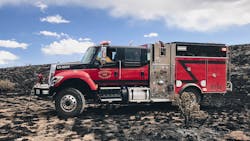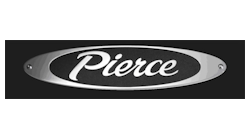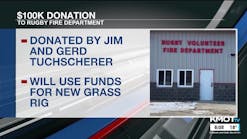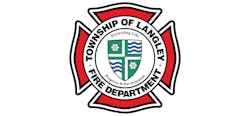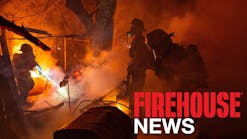Creature Comforts, Technology Make Way to Type 3 Fire Apparatus
Type 3 wildland apparatus help form the backbone of the forest fire vehicle fleet and have for decades. While their design is basic and consistent, there are some evolutionary changes that industry leaders say are showing up on the rigs.
A Type 3 apparatus is a vehicle used for wildland firefighting. They fill a niche between a smaller Type 6 apparatus, which is usually built on a pickup truck-like platform, and a full-feldged structural engine.
Type 3 apparatus are typically built on a heavy-duty four-door commercial cab and chassis with four-wheel drive and are deployed on remote roads, fields and forests. Water tanks are usually 500 gallons with pumps up to 1,000 gpm.
Firehouse talked to three Type 3 manufacturers to learn what’s new in the marketplace. All three indicate that firefighters want more creature comforts and technology as well as more space as deployments and response times increase as fires reach historic sizes.
“Some of these rigs are shuttled all over the country,” said Larry Segreto, vice present of Boise Mobile Equipment (BME), a wildland apparatus builder in Boise, ID. “We’re seeing a lot more calls for 12-volt and USB chargers in the cabs, air ride seats for all occupants and window tinting." He said all those features are being built in for the comfort of the firefighters.
Mike Sweitzer, director of sales for Pierce Mfg.’s Bradenton, FL, division, agrees with Segreto.
“There’s a lot of emphasis on creature comforts,” Sweitzer said. “Type 3 apparatus are very different than a standard pumper or an aerial because of the amount of time crews spend on them.”
Bret Cerini—Spartan Motors account manager for California, Nevada and Arizona, who spent 30 years working for CAL FIRE before moving to Spartan—said apparatus resources are being deployed farther and farther every year.
“When you travel from the middle of Arizona all the way to northern California, you need to be comfortable,” Cerini said. “You’re not going to want a breathing apparatus seat for that kind of trip. You’re going to want an air ride seat.”
BME's observations
For BME’s Segreto, the request for Type 3 apparatus seems to be increasing all the time.
“It seems to be booming,” Segreto said. “We’ve got a backlog even without some of the federal apparatus.” He added BME has at least 150 Type 3 apparatus scheduled to be built in the next 12 months.
From his experience, Segreto said everyone wants to make Type 3 apparatus smaller, but the reality is they are getting bigger. That’s because customers are asking for more compartments to store gear and supplies for longer deployments in increasingly remote areas.
They are also increasing in size because there’s a need for more water, he added. Traditionally, Type 3 apparatus carry 500 gallons of water, and lately customers have been asking for 600 to 750 gallons.
“[Customers] want more equipment to do more things,” Segreto said. “They’re expanding it from a direct attack vehicle.”
Segreto said there’s a movement to have the rigs become more technologically advanced.
“The amount of data communication needs are increasing,” he said. “It’s a little more than ‘can you hear me now.’ Media is reaching firefighters in the wild.”
Segreto said there’s a move to have Wi-Fi in the cabs with the ability to download morning briefings, whole incident plans and providing more information to all firefighters on the scene, not just the crew foremen.
Segreto said the platform for most Type 3 apparatus has been the workhorse International four-door, four-wheel drive cabs and chassis. He’s said Freightliner's have been coming on strong, too, as of late, with aggressive pricing that makes them attractive. It’s up to the customer's preference, Segreto said, adding that the “bread and butter” truck is the still the International.
Regarding the running gear options, Segreto said Allison transmissions still rule the market, as does Meritor axles. As the electronic componentry becomes more efficient, there’s less need for high-amperage alternators, so there’s been a shift to smaller, more efficient and less costly alternators.
When it comes to pumps, BME is building a lot with the CAL FIRE two-stage 500-gpm units, with the vast majority featuring pump and roll capabilities, Segreto said, noting there are a few built with PTO pumps with 1,000- or 1,250-gpm pump ratings. Those are often ordered by fire departments that want a few more points for their Insurance Services Organization (ISO) ratings.
Firefighters have been looking at Type 3 apparatus tires, Segreto said. They still want aggressive tires, but they’re also looking for tires that can be used for highway traveling, too, as the response distances increase. He said departments and forestry agencies don’t want exotic tires because there might not be the support, as in replacements at the scene. Not every department carries spares to save weight and space so they have to rely on replacements at the fire camp.
When it comes to paint, however, Segreto said everything goes these days. It’s not just the green trucks scurrying around the scene. Municipalities are being called upon more and more to help fight forest fires and they have varieties of apparatus colors.
“It can look like Skittles out there on the fire scene these days,” Segreto said. “You’ve got yellow, white, different shades of green, including the U.S. Forest Service green. And there’s always about 47 flavors of red, too. So you’ve got a lot of everything out there.”
Trends viewed from Pierce
For trends, Pierce’s Sweitzer said he hears customers consistently wanting more compartment space for day bags and firefighter personal items.
“They need more space mostly for gear,” he said, noting that departments really have to examine how the apparatus is used in the field when they start specifying compartment space.
Sweitzer said fire pumps for Type 3 apparatus are changing as well.
“We have seen a slight migration away from diesel-driven pumps in favor of hydraulic pumps and that’s in due to green efforts,” Sweitzer said, adding that the main apparatus pump capacities and designs have stayed virtually the same. Some departments are asking for PTO 1,000-gpm pumps for structure fire operations, he said, adding that departments that want pump-and-roll capabilities will gain that back with an auxiliary pump, driven by some other power source.
He said smaller districts that can’t afford, or don’t need, a strict Type 3 exclusive apparatus have been adding some interface equipment, like ground ladders and more hose for interface operations.
Crew comfort is a big deal for Type 3 apparatus, Sweitzer said, noting that a bench seat in the back cab area can sometimes be used for a recovery area or even a bed if necessary.
“We’re recognizing the amount of time guys are spending in these trucks,” he said. “They truly are a different type of apparatus."
Climate-controlled cabs are important and Sweitzer said optional duct working to bring more cool air into the back of the cab is common.
Sweitzer said the Type 3 apparatus have gotten a little taller because of the emission requirements. Most everything to do with the cabs and chassis are up to the original equipment manufacturer (OEM), and there’s not much the apparatus builder can do to make modifications. He said Pierce has been looking at ways to increase storage space with under-cab storage compartments and working with the back bench seat to provide additional storage in the area beneath the cushion.
Freightliner has gained popularity as a Type 3 cab and chassis configuration, Sweitzer said, noting that Freightliner became more attractive with a Cummins 330-hp engine.
There’s also been a movement to provide more rollover protection in the cab for firefighters, as cab OEMs are seeking to have built-in roll cages, Sweitzer said.
Custom cabs and chassis, for Pierce, haven’t been exceedingly popular, Sweitzer said, noting that the company once offered a product called Air Hawk Extreme that was built on an Oshkosh chassis. That was discontinued because of low customer requests, Sweitzer said.
“We don’t see a lot of custom cabs, but I’d like to see more of them,” Sweitzer said, noting that cost and size are limiting factors when it comes to custom cabs and chassis.
Sweitzer said Type 3 apparatus, in their present iteration, have been around for 30 years and are reliable.
“These wildland products have been pretty proven,” he said. “They’re built to be robust to operational standards. We just need to get the new technologies into these apparatus.”
Spartan sees changing styles
Making that technology fit and work on small apparatus can be a challenge, said Spartan’s account manager Cerini. Among that technology is a growing and different communications needs, he said. In addition to data communications, Cerini said, fire departments need to think about radios.
“We try to ask our customers to think about how many radios they might need,” he said. “A lot of municipalities use 800-band radios. Many are in the 150 range. You think about who you might need to talk to. Will you need to talk to command, talk air to ground to unit radio? You need to find a place for all the radios you might need.”
Cerini said the center consoles in the cabs of apparatus are critically important to have designed properly given the limited space. He said Spartan has had some success with using space between two bucket seats in the back of the cabs. That also provides more comfortable seating for the occupants while providing some additional space for communications equipment.
However, there are some instances where a bench seat is more appropriate given the fact that some crews require five people and four bucket seats wouldn’t work for that mission, he said.
Another cab trends Cerini said he’s noticed recently is a greater emphasis on rollover protection. Builders in Europe and Australia have been advancing protection, and he said he has seen growing interest in it here in the United States.
Another thing that’s becoming a point of interest is breathing air in the cabs for burnover protection, Cerini said.
When it comes to cabs, custom cabs might afford some additional space; they also offer some challenges when it comes to maintaining them on the fire scenes, Cerini said, adding that European cabs and chassis can also present problems.
“You might be able to maintain them in your community, but it’s a different story out on a strike line,” Cerini said. “You’ve got to be able to maintain them outside your district. … A large fire camp is instantaneously a small city. It has all the support and the mechanical support for mission, like tires, hoses and belts. All that has to be accounted for. If you get something different, it will be very difficult for fleet to repair or maintain it.”
When it comes to pumps, Cerini said there have been some recent trends to more two-stage pumps which can produce much higher pressures up inclines and over long hose stretches.
“States in the West and in the Rockies need much higher pump pressures,” Cerini said.
Class A foam systems and even compressed air foam systems (CAFS) are showing up more on Type 3 apparatus these days, Cerini said.
“In the days of old, we squirted water,” he said. “Now Class A foam and CAFS are good tools in the hands of qualified operators."
Cerini said when departments are considering foam systems, including CAFS, they need to “check all the boxes,” such as space requirements, increase initial costs and serviceability. He said as foam becomes more common on the wildland fire scenes, camp mechanics are more familiar with repair and maintenance. He said many components are now “plug and play” so they are serviceable in the field.
“Class A foam and CAFS are water extender by all means,” Cerini said, pointing they can be valuable assets when a crew is far from a hydrant or other water source. “They are force-multiplier no doubt. They add a little more initial expense, but as long as you can check all the boxes, you should consider it.”
Foam systems and even slightly larger pumps make Type 3 apparatus more versatile and, perhaps more justifiable for municipalities to purchase over a single-use apparatus.
“If we can get a little more multi-function out of it with a larger pump, it can become an initial attack apparatus for structure fires,” Cerini said. “It give you a little more bang for the buck.”
While Type 3 apparatus may be asked to do more and more, they still need to be maneuverable, Cerini said.
“We’re asked to put all of this on a small package that can navigate small mountain roads,” Cerini said. “We try to do that with space efficiencies, but they are getting bigger and taller.”
Cerini said that when it comes to what is placed on the apparatus, fire departments have to balance the requirement and standards recommended by the alphabet soup of private, state and federal agencies.
He said most departments and firefighters are looking to maximize storage across the board. He recommends departments look at the mission, and consider the number of crew bags needed, the length of deployments, how much water and Gatorade will be needed, as well as the amount of food that will be carried.
Even things like sleeping bags, mats, pads and even tents might have to be carried on the apparatus, all of which take space on the rig, Cerini said.
“We try to keep them small, but at the same time, they’ve got to carry all this gear,” Cerini said. “It can be a challenge.”
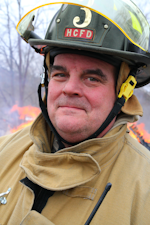
Ed Ballam
Ed Ballam served as associate editor for Firehouse. He is the assistant chief of the Haverhill Corner, N.H. Fire Department, and a National Registered EMT. He is also a Deputy Forest Fire Warden for the New Hampshire Division of Forests and Lands. Professionally, he's been a journalist for over 35 years working for a variety of publications, including employment as managing editor of a national fire service trade journal for more than a decade.
